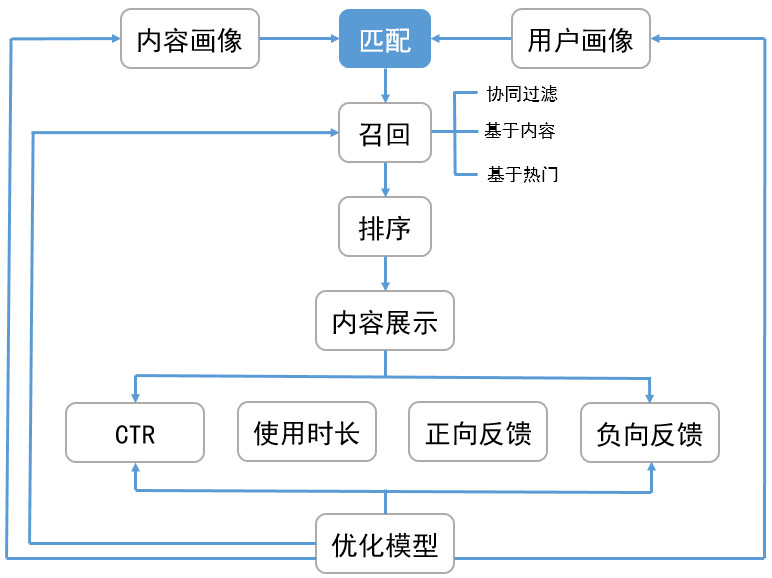Recommendation System
推荐系统架构

Matching
召回算法Match:包含多个渠道的召回模型,希望从资源库中选取 多样性偏好内容,缩小排序目标
- 协同过滤
- 主题模型
- 内容召回
- 热点召回
Ranking
排序:对多个召回渠道内容打分、排序、选出最优的少量结果
- 若召回结果仍包含大量数据,可以考虑分为两个阶段
- 粗排:进一步剔除召回结果
- 精排:对粗排结果再次打分、排序,得到最终推荐结果
Collaborative Filtering-Based Recommendation
基于协同过滤推荐算法:推荐算法中主流
模型一般为n个物品、m个用户的表
- 只有部分用户、物品之间有评分数据
- 要用已有部分稀疏数据预测空白物品、数据之间评分关系, 推荐高评分物品
无需太多特定领域的知识,可通过基于统计的机器学习算法得到 较好推荐效果,可以分为
- 基于用户
- 基于物品
- 基于模型
- 现在指推荐算法一般指协同过滤,其他基于内容、规则、人口 统计信息等都被包含/忽略
User-based
基于用户协同过滤:主要考虑用户之间相似度,找出相似用户、相似 用户喜欢的物品,预测目标用户对对应物品的评分,推荐高评分物品
特点:(相较于Item-Based)推荐更社会化
- 反映用户所在小型兴趣群体中物品热门程度
- 可帮助用户找到新类别、惊喜物品
适合场景
- 用户数量较少、变化慢场合,否则更新、计算用户相似度矩阵 代价大
- 时效性强、用户个性化兴趣不明显领域
- 无需给出推荐解释
- 示例
- 新闻推荐:注重热门、时效、item更新快
- 热点视频推荐
方法
- 基于规则:大众型推荐方法,如:最多用户点击、浏览
- 基于人口统计信息:简单根据用户基本信息发现用户相关 程度、推荐
- 混合推荐
- 结合多个推荐算法,集成算法推荐结果
- 复杂度高
Item-Based Collaborative Filtering
基于项目协同过滤:考虑物品和物品之间的相似度,找到目标用户 对某些物品的评分,预测用户对相似度高的类似物品评分,推荐高 评分相似物品
特点:(相较于User-Based)推荐更个性化
- 反映用户自身的兴趣传承
- 可帮助用户深入挖掘自身兴趣
- 准确度一般
- 推荐多样性弱,难以带来惊喜
适合场景
- 物品数量较少、变化慢场合,否则更新、计算物品相似度 矩阵代价大
- 长尾物品丰富、个性化需求不明显
- 需要向用户给出推荐理由
- 示例
- 电商
- 电影:兴趣持久、更个性化
Model-Based Collaborative Filtering
基于模型:目前最主流的协同过滤类型
关联算法:找出用户-物品数据里频繁出现的项集,作频繁集 挖掘,推荐频繁集、序列中其他物品
- Apriori
- FPTree
- PrefixSpan
聚类算法:按照用户、物品基于一定距离度量聚类,推荐高评分 同类物品、同类人群 (类似于基于用户、物品协同过滤)
- K-means
- BIRCH
- DBSCAN
- Spectral Clustering
分类算法:使用分类模型划分物品
- 逻辑回归
- 朴素贝叶斯
回归算法:使用回归模型给物品预测打分,较分类更平滑
- 线性回归
- 决策树
- SVM
矩阵分解:对用户-物品评分矩阵进行分解
- FunkSVD
- BiasSVD
- SVD++
- 还有基于图模型、神经网络等新模型
- 还有依赖于自然语言处理NLP,通过挖掘文本内容特征,得到 用户的偏好,进而做推荐,同样可以找到用户独特的小众喜好